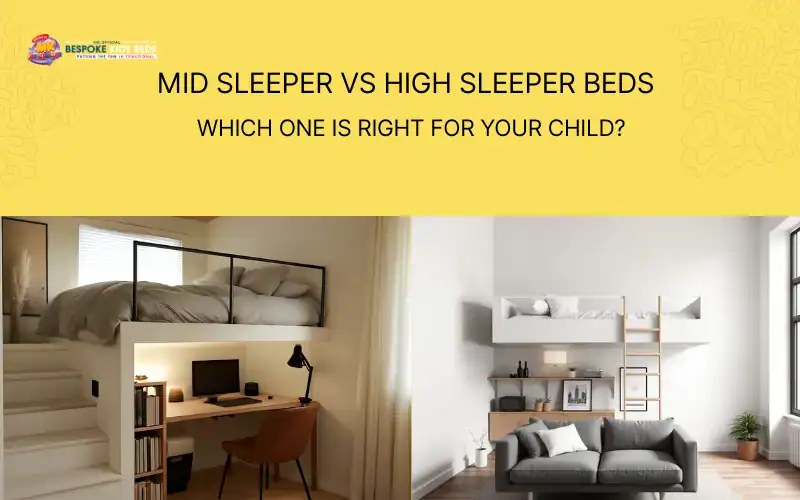
What Is a Trundle Bed? Types, Benefits, and Buying Guide
A trundle bed, also known as a truckle bed, is a highly versatile and space-saving solution featuring a second, lower bed frame that is neatly
Enjoy FREE Delivery on All Orders!

A mid sleeper bed is better for younger children due to its lower height and easier access, while a high sleeper bed is more suitable for older kids who need more functionality and floor space. Both types of space-saving beds include built-in features such as storage, desks, or play zones, but their design and usage differ significantly.
This blog explains the key distinctions between mid sleeper and high sleeper beds by comparing their height, safety, storage potential, and day-to-day usability. Whether you’re furnishing a compact room or planning for growing needs, this guide will help you choose the right bed to match your child’s age, lifestyle, and bedroom layout.
A mid sleeper bed is a raised children’s bed positioned slightly higher than a standard single but significantly lower than a high sleeper. Typically measuring between 110 cm and 140 cm in height, it offers usable space underneath for built-in storage, play zones, or compact desks, making it ideal for small rooms.
Designed for children aged 4 and above who have outgrown toddler beds, it provides a safe climbing height with easy access. Many models include drawers, shelves, or cupboards to help keep the bedroom organised. Its balanced design supports both sleeping comfort and practical space-saving, which makes it a popular choice for families looking for sturdy, kid-friendly beds in compact or shared bedrooms, like a kids mid sleeper bed.
A high sleeper bed is a tall, elevated children’s bed designed to maximise vertical space, usually standing between 170 and 200 cm in height. These space-saving beds make excellent use of room height, and the area underneath is often fitted with desks, wardrobes, futons, or extra storage.
Also known as loft beds, children’s high sleeper beds are best suited for kids aged 6 and above who can safely manage taller ladders. A high sleeper single bed is ideal for small bedrooms where every square metre matters. These kids high sleeper beds combine sleep, study, and storage in one compact structure, perfect for flexible layouts or shared rooms.
Mid sleeper and high sleeper beds differ mainly in height and function with mid sleepers being lower and safer for younger kids and high sleepers providing more space underneath. Mid sleepers are easier to access, making them ideal for younger children, while high sleepers stand taller and offer extra floor clearance perfect for desks, wardrobes, or seating below. Choosing between them depends on your child’s age, bedroom layout, and how much extra space or storage you need from the bed. Here are the key differences between them.
Mid sleeper beds range from 110-140 cm in height, while high sleeper beds usually exceed 170 cm. This height difference affects accessibility and the type of space available underneath.
The additional height in high sleepers allows for multi-use configurations, but it also requires the child to climb higher, which may not suit every age group.
| Feature | Mid Sleeper Bed | High Sleeper Bed |
| Height Range | 110cm to 140cm | 170cm+ |
| Ideal Age Range | Younger children (ages 3-7) | Older children, teens, or adults |
| Access | Easier to climb due to lower height | Requires a ladder or steps for access |
| Space Below the Bed | Storage and play area | Larger storage, desk, or lounge area |
Both mid sleeper and high sleeper beds are generally suitable for children aged 6 years and above, as this age group has the coordination and judgment needed for elevated sleeping platforms. Mid sleepers offer safer access and lower injury risk while high riser beds require greater climbing ability, making it important to follow safety guidelines for high sleeper beds.
When selecting a bed, key safety features to look for include:
High sleepers save more floor space than mid sleepers by offering full-height clearance beneath the bed. While both are space-saving options, mid sleepers create compact zones for drawers or toy boxes, suitable for small children’s rooms. High sleepers take advantage of vertical space, accommodating desks, wardrobes, or futons underneath. If you have limited floor area but generous ceiling height, then high sleeper beds can help you make the most of the area. Mid sleepers work best in rooms with lower ceilings and simpler space needs.
When it comes to built-in storage and multifunctional use, high sleepers offer more capacity and flexibility than mid sleepers. Their taller structure creates room for larger features like study desks or full-length wardrobes, supporting more complex daily routines.
Meanwhile, mid-height beds, with their lower frame, focus on accessible storage such as drawers, open shelves, or pull-out units. The right choice depends on whether your child needs simple, reachable storage or a more advanced combination of study and organisation space.
| Feature | Mid Sleeper Bed | High Sleeper Bed |
| Storage Capacity | Smaller storage areas like drawers and shelves | Larger storage options, including desks and seating |
| Storage Placement | Under-bed storage, often compact | More floor space underneath for larger storage or multi-functional use |
| Ideal Age Group | Younger children (ages 3-7) | Older children, teens, or adults |
For everyday convenience and safer climbing, mid sleepers outperform high riser beds in terms of ease of access. Their shorter ladders and lower entry points make them more manageable for younger children to use independently. High sleepers, while offering more under-bed functionality, involve steeper climbs that may require supervision or pose a challenge for less confident climbers. Evaluating your child’s routine and mobility can help determine which option fits better with your family’s day-to-day habits.
The design of mid sleeper beds is simple and practical, featuring basic functionality like storage or play areas beneath. These beds are ideal for younger children or compact rooms.
High sleeper beds, however, are more elaborate, with the option for built-in desks, shelves, or lounges under the elevated sleeping area. These designs maximize space and offer more versatility, making them suitable for older children or teens who need more room for activities.
Mid sleeper and high sleeper beds come in a range of styles designed to save space and suit children of different ages and needs. Below are the common variants for each type:
Mid Sleeper Bed Variants:
High Sleeper Bed Variants:
Mid sleeper beds are practical for families seeking compact, child-friendly furniture, but like any product, they have their advantages and limitations.
Pros:
Cons:
A mid sleeper is best for early school-age children who need both sleeping comfort and simple storage within arm’s reach.
The benefits of high sleeper beds include maximising space and adding functionality, especially in compact rooms, but they come with a few trade-offs to consider.
Pros:
Cons:
High sleepers are ideal for confident climbers aged 6+ who need a functional, all-in-one furniture solution for study, storage, and sleep.
Selecting the right bed starts with your child’s age, confidence with climbing, and the layout of their room. These factors impact both safety and day-to-day use, so it’s important to choose a bed that supports your child’s habits and space. Mid sleepers are great for younger children who need easy access and basic storage, while high sleepers are better for older kids who need study or lounge zones under the bed.
To guide your decision, consider:
MK Furnishings provides a variety of space-saving bed options for growing children and smaller UK homes. From functional mid sleepers with built-in drawers to elevated kids’ high sleeper ideas featuring desks and wardrobes, each design is tailored to fit your child’s space and daily needs.
For accessible storage and safer climbs, consider our children’s bunk beds or kid-friendly mid sleepers. If you need more functionality, our high sleeper beds with stairs provide extra room for study or storage without taking up floor space.
All beds come with secure guardrails, sturdy ladders, and smooth finishes. We also offer delivery, assembly, and flexible finance options to make your shopping experience seamless.
A mid sleeper bed stands between 110 cm and 140 cm high. This lower elevation allows for safe climbing and compact under-bed storage like drawers or toy boxes, making it ideal for smaller rooms or younger children.
High sleeper beds usually measure between 170 cm and 200 cm in height. This taller design creates enough space underneath for desks, wardrobes, or seating areas, making it a strong choice for space-saving bedrooms.
Both mid and high sleeper beds are generally recommended for children aged 6 years and older. This age range ensures your child has the coordination and awareness needed to safely use ladders and elevated platforms.
Yes, a high sleeper is suitable for small rooms as long as the ceiling height is at least 9 feet (2.7 metres), allowing for a minimum clearance of 76 cm between the top of the mattress and the ceiling. This vertical space ensures your child can sit up safely and move comfortably while in bed. High sleepers are especially effective in compact rooms where floor space is limited, as they allow for integrated desks, wardrobes, or seating areas beneath the bed.
Yes, many mid sleeper beds can be converted into high sleepers using an extension kit if they are part of a modular system. This allows families to adapt the bed as their child grows, transitioning from a lower, easy-access setup to a more functional high sleeper with added storage or study space. Always confirm with the manufacturer or product guide to ensure the model supports safe and compatible conversion.
Look for strong guardrails, secure ladders with wide non-slip steps, rounded edges, and compliance with UK safety standards such as BS EN747. Proper installation and room clearance are also key to safe use.
High sleepers generally offer more storage flexibility with space for desks, wardrobes, or lounge areas underneath. Meanwhile, mid sleepers provide accessible storage like drawers and shelves, which are easier for younger children to reach.
Kyle Kane
Owner
Kyle Kane is Co-Owner of MK Furnishings, a family-run business based in UK that specializes in high-quality custom kids’ bunk beds, including triple, double, single, and themed designs. Since launching the company in 2016 alongside his brother-in-law, Kyle has helped deliver and assemble thousands of beds across the UK, Ireland, and beyond. Focused on customer satisfaction, Kyle leads a hardworking team that handles every step from ordering to delivery ensuring a smooth and professional service. His commitment to quality craftsmanship and reliable support has earned MK Furnishings a strong reputation and growing customer base throughout the region.

A trundle bed, also known as a truckle bed, is a highly versatile and space-saving solution featuring a second, lower bed frame that is neatly

The best way to choose a mattress for kids is to focus on safety, comfort, and suitability for their age and sleeping needs. A supportive
Fancy £50 off all orders! Enter in 50off to redeem in the coupon code section